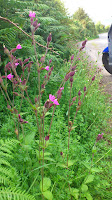
Spreading the
Biodiversity!
Collecting Campions Sustainably from the wild.
 1)Getting a good root ball and 2)not diminishing the local population are probably the 2 most important factors to be considered before choosing a clump, that looks like it can be thinned out a bit.
1)Getting a good root ball and 2)not diminishing the local population are probably the 2 most important factors to be considered before choosing a clump, that looks like it can be thinned out a bit.
Select a thriving, tangled clump of campion and carefully dig up some that are maybe congested, within the clump. I just use my fingers, but a trowl would be more frequently recommended.
There is always a small hole left within the clump, from where the selected plants were taken, so best to find a bit of spare soil, which has say; fallen off the bank or onto the road or a Mole earth and gently fill in any holes. It is not good to leave any mess, bad practice or holes.
Collecting a good number of specimens of a species and from many different local sites; makes for a healthy and diverse gene pool. Especially since their new home is surrounded by so much moor that pollinating insects would have a job to cross it, so the plants up there will most probably have to interbreed. So if I get a good mix to Begin with; their long term future won't get hampered by weaknesses caused by too much inbreeding.In short, I want to set up healthy breeding colonies of as many suitable native plants as possible.
Collecting Campions Sustainably from the wild.
 1)Getting a good root ball and 2)not diminishing the local population are probably the 2 most important factors to be considered before choosing a clump, that looks like it can be thinned out a bit.
1)Getting a good root ball and 2)not diminishing the local population are probably the 2 most important factors to be considered before choosing a clump, that looks like it can be thinned out a bit.Select a thriving, tangled clump of campion and carefully dig up some that are maybe congested, within the clump. I just use my fingers, but a trowl would be more frequently recommended.
There is always a small hole left within the clump, from where the selected plants were taken, so best to find a bit of spare soil, which has say; fallen off the bank or onto the road or a Mole earth and gently fill in any holes. It is not good to leave any mess, bad practice or holes.
Collecting a good number of specimens of a species and from many different local sites; makes for a healthy and diverse gene pool. Especially since their new home is surrounded by so much moor that pollinating insects would have a job to cross it, so the plants up there will most probably have to interbreed. So if I get a good mix to Begin with; their long term future won't get hampered by weaknesses caused by too much inbreeding.In short, I want to set up healthy breeding colonies of as many suitable native plants as possible.

As shown on the picture on the above; a good sized root ball had been dug up with the plant, so it had much more chance of survival when transplanted and will settle in much fasted to it's new home.
 I immediately transfer young plants to a damp plastic bag, to keep them moist, until I can plant them, which should be done as soon as possible and in a similar kind of habitat to where they were found.
I immediately transfer young plants to a damp plastic bag, to keep them moist, until I can plant them, which should be done as soon as possible and in a similar kind of habitat to where they were found.
 I immediately transfer young plants to a damp plastic bag, to keep them moist, until I can plant them, which should be done as soon as possible and in a similar kind of habitat to where they were found.
I immediately transfer young plants to a damp plastic bag, to keep them moist, until I can plant them, which should be done as soon as possible and in a similar kind of habitat to where they were found.Campions are what I would call an edge of woodland plant. They like clearings of edges of woods, not minding conifers too much.
They will not occupy grassland, in less there are trees nearby and they thrive in hedges, since there, the get the best of both worlds; sun light and organic material.
Campions form clumps quite fast, but have difficulty dispersing their seed very far. Sometimes collecting seeds and sprinkling them on some hedge-side mole hills or bare earth is a more efficient way of doing it.



 Much of the land and valley directly behind Dartmoor prison is ungrazed and full of all manner of odd little stone bridges, an aqueduct and much wildlife. There is no fishing here and few tourists ever find it.
Much of the land and valley directly behind Dartmoor prison is ungrazed and full of all manner of odd little stone bridges, an aqueduct and much wildlife. There is no fishing here and few tourists ever find it.



